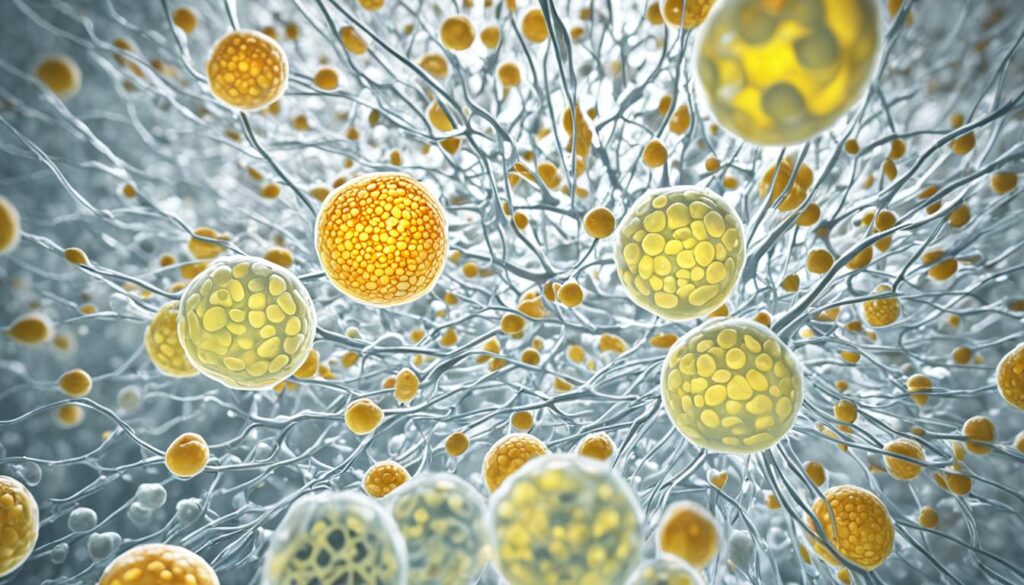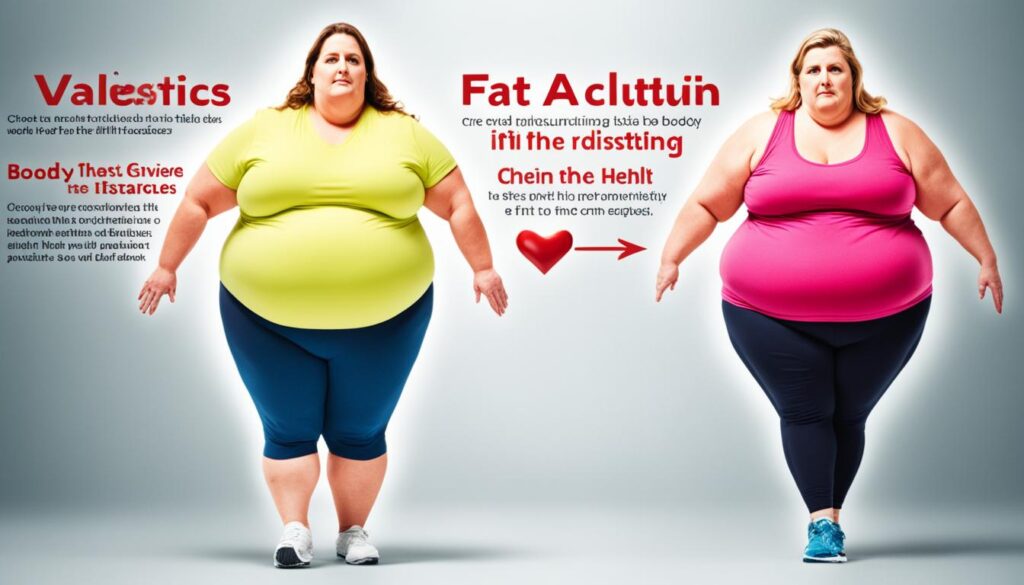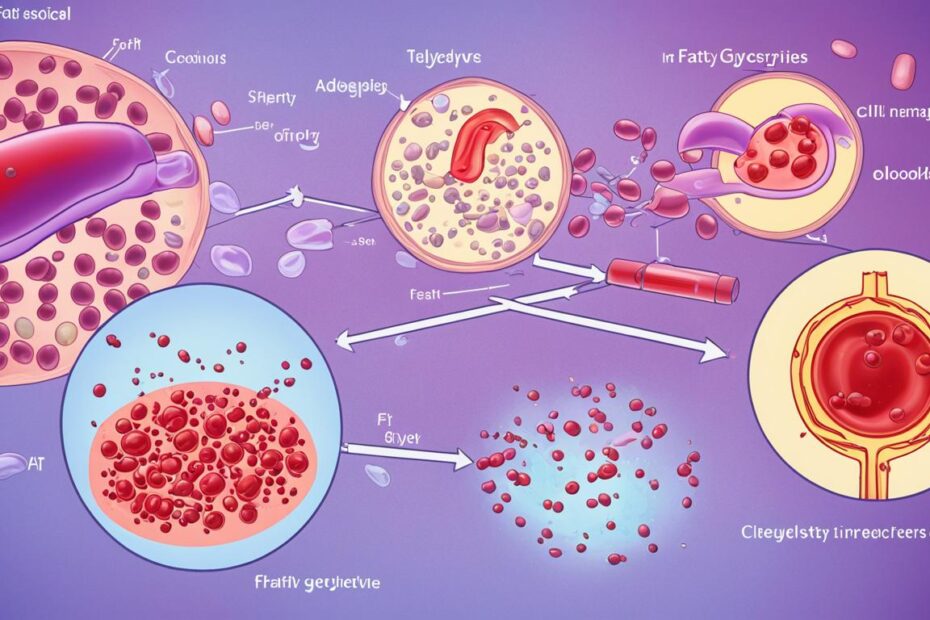Have you ever wondered where fat goes when you lose weight? The magic behind it is called fat metabolism. It’s a super interesting and cool part of how our bodies work.
The key player in burning fat is lipolysis. This is when your body breaks down stored fat into fatty acids and glycerol. But why and how does this happen?
It all starts when your body needs more energy than you eat. This creates an energy shortage. Then, special hormones in your body tell it to use up the stored fat for energy.
After that, the fat parts – fatty acids and glycerol – move through your blood to different parts of your body. There, they can be burned to make ATP. And ATP is what your body uses for energy.
Think of your fat cells like tiny powerhouses. They’re always ready to give your body the energy it needs. This way, your body keeps going strong.
The question now is: what helps your body burn fat better? And what can you do to speed up weight loss?
Soon, we’ll talk about how fat is stored and moved around your body. We’ll also cover how exercise fits into the fat-burning story. Plus, we’ll look at what happens to fat when you lose weight. And we’ll share tips for burning fat more effectively.
Get ready to dive into how fat burning works. You’ll learn all about the science of losing those extra pounds.
Adipose Tissue: The Storage Site of Fat
Adipose tissue, or fat tissue, saves extra energy in our bodies. It is made of cells called adipocytes. These cells store fat in big droplets that are mostly triglycerides.
There’s white adipose tissue (WAT) and brown adipose tissue (BAT). White tissue is more common, and it helps keep us warm, protects organs, and gives us energy when we haven’t eaten. Brown tissue helps make heat. It has lots of mitochondria, which are like power stations in our cells, and small fat droplets. Brown fat is vital for keeping babies warm and for managing our weight as we grow up.
Men and women have different kinds of fat in their bodies. Men usually store fat around their organs. Women often put their extra fat just below their skin.

The Functions of Adipose Tissue:
- Energy storage: Adipose tissue stores extra energy to use later.
- Insulation and cushioning: It helps keep us warm and protects our organs.
- Hormone production: Adipose tissue makes hormones that control our hunger, weight, and health.
- Vascularization: It has blood vessels to feed cells and carry things the body needs.
So, adipose tissue is more than just a place to store fat. It’s a key player in how our bodies use energy and control weight. Knowing about it helps us understand fat and health better.
Factors Affecting Fat Distribution
Fat can sit in different places in our bodies. Men often have more fat near their organs, making their shape look like an apple. Women, on the other hand, tend to keep fat in their hips and thighs, looking like a pear. This is because of genes and hormones that are different for men and women.
But having too much fat in certain spots can be bad for our health. More fat around the upper body can cause heart problems, high blood pressure, and diabetes. Yet, if the fat is mostly in the lower body, it might cause trouble moving.
If someone diets a lot, gaining and losing weight, it could be bad news for how fat is stored.

The Role of Calories in Fat Storage and Burning
Wanna know how fat burning works? Let’s talk about calories. Calories are energy units from food and drinks. Too many calories can store as fat.
But, less calories than needed creates a deficit. Then, fat is used for energy. The body uses any stored fat, not just from certain spots.
Eating less and moving more creates this deficit. This makes the body burn its fat. So, diet and exercise are key.
When fat breaks down, we get fatty acids. They go to the muscles and liver to make energy. This energy is what we need every day.
The Importance of Energy Expenditure
How we use energy is crucial for burning fat. There are three parts to it: BMR, TEF, and PAL. BMR is for resting functions. TEF is from digesting food. Physical activity includes exercise.
Boosting energy use is good for fat burning. Exercising and being active help. They speed up metabolism, burning more fat.
- Try aerobic exercises, like walking or cycling, to burn more fat.
- Add in strength training to build muscle. More muscle means more fat burn all day.
- Be active daily. Walking and little tasks help you burn more fat.
Knowing about calories and fat is helpful. Diet and moving help you balance. A healthy lifestyle keeps your body fit.
The Process of Fat Burning During Exercise
Exercising makes the body use stored energy. This helps in moving and doing activities. Burning fat is a big part of this, as the body uses its fat stores for fuel. Learning about fat burning during exercise can help folks make the most of their workouts.
In the beginning, your body depends on glycogen. This is stored from carbs and is a quick energy source for intense activities. but, after about 30 to 60 minutes of aerobic exercise, glycogen runs low.
When the body runs out of glycogen, it turns to fat. This is called fat oxidation. Fat molecules are turned into energy. This is when the body burns fat the best, so it’s great for losing fat.
Doing activities like swimming or dancing helps with fat burning. They use a lot of energy and boost fat oxidation, leading to more fat loss. Also, strength training builds muscle. This helps burn more calories and fat, even when you’re resting.
Building muscles by strength training is very good for burning fat. It makes your body use more energy, even when doing nothing. Muscles also need more energy to stay than fat does. This makes your body burn more fat.
Burning fat during exercise involves many body processes. Mixing aerobic exercises with strength training can boost fat burn. It helps achieve the body shape you want.
The Fate of Fat During Weight Loss
Knowing what happens to fat during weight loss is key. Our bodies break down fat for energy as we lose weight. So, what happens to these fat molecules from our adipose tissues?
While losing weight, the body uses fat for energy. This releases water and carbon dioxide. You get rid of the water through sweat and urine. Plus, you breathe out the carbon dioxide.
Metabolism is crucial for breaking down fat. It changes stored fat to useful fuel for the body. When we breathe faster during exercise, we help get rid of carbon dioxide better.
Fat and muscle are not the same. They are different tissues with different jobs. The body uses fat stores for energy. This helps lower overall body fat over time.
Knowing about fat loss guides us in staying healthy. We can do this by watching our food intake, doing fun exercises, getting enough sleep, and eating mindfully. These steps help our bodies lose fat naturally.
To learn more about fat breakdown during weight loss, check out these resources:
- WebMD: What Happens to Fat When You Lose
- Healthline: Where Does Fat Go When You Lose Weight
- CNN: The True Story of Fat
Understanding what happens to fat when we lose weight is valuable. It allows us to make smart choices for a healthier life.
Strategies for Effective Fat Burning
To lose weight well, combine a few strategies. Watch what you eat, exercise a lot, sleep enough, and eat mindfully.
1. Caloric Intake: You need to eat fewer calories to burn fat. Keep track of what you eat and control how much you eat. Doing this creates a good calorie shortage. This makes your body use fat for energy.
2. Exercise: Being active helps burn fat. Include cardio and strength workouts in your plan. Try to exercise 30 minutes every day, then build up slowly.
3. Sleep: Good sleep is important for fat loss. It helps keep your energy levels in check. Make sure to get 7-9 hours of sleep without interruptions each night.
4. Mindful Eating: Pay close attention to what, how, and when you eat. Enjoy your food without distractions. Listen to your body’s hunger and fullness signs. This helps you avoid too much food and pick healthier options.
Use these strategies daily to lose fat well and keep the weight off. It takes time and staying consistent to see results in a healthy way.
Sustaining Fat Loss and Healthy Lifestyle Habits
Losing weight and staying healthy is all about stick-to-itiveness and steady work. It’s good to understand that getting in shape takes time. You won’t see huge changes overnight. But, keeping at it will pay off in the end.
Being active is crucial for keeping off the pounds. Try to do 30 minutes of cardio most days. This can be anything that gets your heart pumping. Dancing, biking, or playing sports all count. Working out on machines at the gym is great too.
It’s not just about slimming down. Exercising also makes you feel good and sleep better. Don’t forget about strength training too. Lifting weights or doing exercises with bands twice a week helps keep you strong.
Getting advice from doctors or diet experts can really help. They’ll give you a plan that’s made just for you. This plan will include steps to change your habits and ways to check your progress. Talking to these pros can keep you healthy and on the right track.
Eating the right kinds of food is super important for losing weight. Eat lots of veggies and fruits every day. Healthy oils are good for you, but they are also high in calories. Be careful with processed foods. They are usually packed with too much fat, sugar, or salt. Picking whole foods is your best bet for staying on track with your weight goals.
Staying healthy for life takes work. Remember to move a lot, get advice from doctors or experts, and choose your food wisely. If you keep these tips in mind, you’ll be on your way to a healthy weight and a happier you.
Sources: Mayo Clinic, Forbes, Harvard Health
